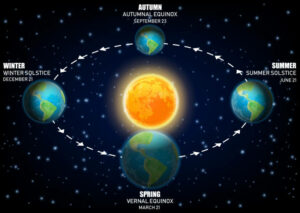Autumn Definition, Characteristics, & Facts

Autumn, also known as Fall, is one of the four temperate seasons. Autumn marks the transition from summer to winter, in both the Northern and Southern Hemispheres. This season is associated with the harvest and with the changing colors of leaves. In the Northern Hemisphere, autumn typically runs from September to November. In the Southern Hemisphere, it runs from March to May. Autumn is a time of change. The leaves of deciduous trees change color and eventually fall off, signaling the start of winter. The days grow shorter and the nights grow longer. The weather becomes cooler as the season progresses. ###
The definition of autumn according to the dictionary
The dictionary definition of autumn according to the Merriam-Webster Dictionary is “the season of the year between summer and winter when the weather becomes cooler and the leaves of trees turn yellow, red, or brown.”
Autumn is typically associated with the colors of falling leaves, cooler temperatures, and cozy fires. For many people, autumn is a time to enjoy the outdoors before the cold of winter sets in. Activities like hiking, apple picking, and pumpkin carving are popular during this season.
Characteristics of autumn include shorter days as the earth tilts away from the sun, lower humidity levels, and a decline in temperature. In terms of plant life, deciduous trees begin to prepare for winter by shedding their leaves. The changing colors of fall leaves are due to a decrease in chlorophyll production and an increase in carotenoids.
While autumn technically starts on September 22nd or 23rd each year (depending on the year), meteorological autumn in the Northern Hemisphere begins on September 1st. This is because meteorological seasons are based on average temperatures rather than astronomical events.
Whether you’re enjoying the cool weather or looking forward to Halloween and Thanksgiving celebrations, autumn is a wonderful time of year!
The characteristics of autumn
One of the main characteristics of autumn is the shedding of leaves from deciduous trees. In the Northern Hemisphere, autumn is usually associated with cooler temperatures and shorter days, while in the Southern Hemisphere, autumn is usually associated with warmer temperatures and longer days. Some cultures consider autumn to be a time of harvest, while others see it as a time of preparation for winter.
Autumn generally begins in September in the Northern Hemisphere and March in the Southern Hemisphere. The exact dates can vary depending on location and climate. The length of autumn also varies, but it typically lasts about three months in most parts of the world.
During autumn, leaves change color and eventually fall off the tree. This process is called abscission. Most deciduous trees lose their leaves during autumn, but there are a few exceptions such as evergreens and some tropical trees.
The changing colors of leaves are caused by a combination of factors including decreased daylight hours, changes in temperature, and decreased levels of chlorophyll (a green pigment found in leaves). As daylight hours shorten and temperatures cool, chlorophyll production decreases which causes other pigments such as carotenoids (yellow and orange) and anthocyanins (red) to become more visible.
How to celebrate autumn
As the leaves begin to change color and the air becomes crisp, autumn is a wonderful time to celebrate the bounty of the season. Here are some ideas for how to celebrate autumn:
- Go for a scenic drive or hike and take in the beauty of the changing leaves.
- Visit a local farmers market or pick your own apples and pumpkins.
- Make a seasonal dish using fresh ingredients from the harvest.
- Attend a fall festival or go on a hayride.
- Spend time with friends and family around a bonfire.
- Take a trip to see the stunning fall foliage in New England or another part of the country.
- Give thanks for all that you have been blessed with during this harvest season.
You may also like;
- Who is Mcdonalds Ray Kroc?
- What are Lipids Used For?
- Who is René Descartes?
- The Story of Noah’s Ark:
- What is Rhythm in Music?
Frequently Asked Questions on Autumn
What happens in autumn season?
As the weather cools down and the leaves start to change color, autumn is in full swing. This season brings a time of harvesting crops and enjoying the bounty of nature before the cold winter sets in.
Autumn is a time to enjoy the fruits of your labor and take in all that nature has to offer. The leaves changing color is one of the most beautiful aspects of this season, and it’s also a cue to start preparing for winter. Crops are harvested, fires are lit, and cozy sweaters come out of storage. There’s something special about autumn that makes it a favorite season for many people.
Which month is autumn season?
The autumn season typically runs from September to November in the Northern Hemisphere, and March to May in the Southern Hemisphere. The exact dates can vary depending on the specific location. In general, autumn is characterized by cooler temperatures, shorter days, and falling leaves.
Why is it called fall autumn?
There are a few different theories as to why the season is called fall or autumn. One theory suggests that the word “fall” comes from an old Germanic word meaning “to fell,” or cut down (as in trees). This makes sense, as fall is a time when leaves falling from trees are often associated with the season.
Another theory suggests that the word “autumn” comes from the Latin word for “harvest.” This makes sense as well, as fall is typically a time of year when crops are harvested.
Whatever the origin of the name, there is no doubt that fall is a beautiful time of year!
Conclusion
Autumn is one of the four temperate seasons and is associated with cooler weather, shorter days, and the start of the school year. In North America, autumn typically runs from September to November. The equinoxes mark the beginning and end of autumn in most cultures, but some traditions (such as the Chinese) begin autumn on different dates. Many people enjoy autumn for its cool weather and beautiful scenery; others find it a difficult time of year because it signifies the end of summer.
Last Updated 7 months by wpadmin










